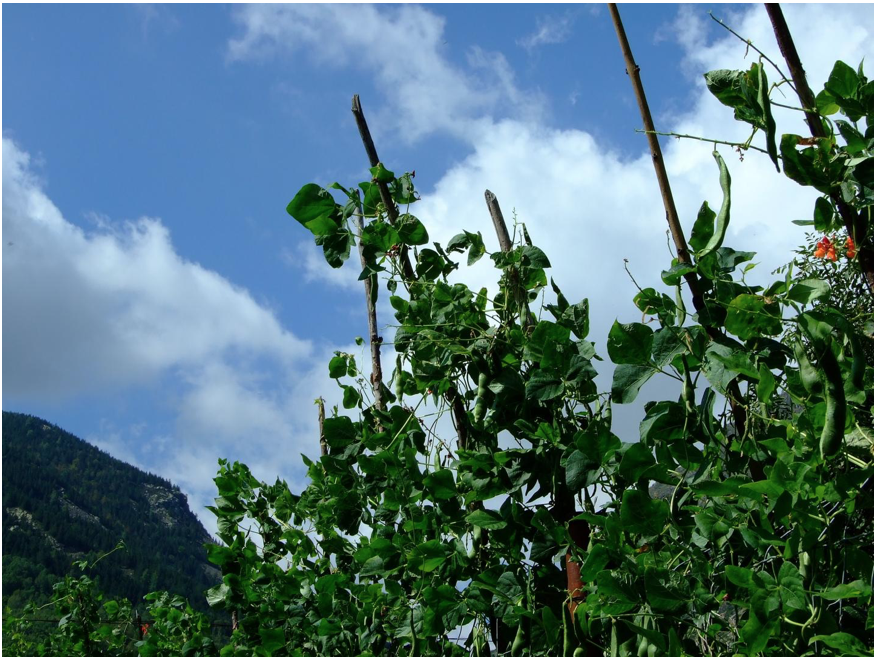Crop: Phaseolus coccineus L. (Runner bean )
Traditional landrace of bean from Vall Fosca, in the Lleida region of Pallars Jussà, registered in the municipality of La Torre de Cabdella.
Dry grains are used for human food. For its consumption, it is boiled with plenty of water and eaten only with a splash of olive oil, with a tomato sauce or stewed meat. Some gardeners have also highlighted its ornamental use since its white and red flowers give color in the garden.
The fruit is a dark green and hairy pod. Grain colors white, red-lilac with black or black spots, 2-3 cm in length. It is a perennial herbaceous plant, with simple dark green leaves. It is of indeterminate growth, reason why it can get to reach four meters of height. The flower is white or red.
The farmers remember the landrace of all the life and they talk about that their parents already cultivated it, what implies that it has been in the valley for more than 100 years.
It is a tall bean that is used for the consumption of dry beans. Although it is a perennial plant, it is grown as an annual, so it is sown and the bushes are plucked every year.
It is sown at the beginning of May, directly on the ground in shallow holes.
The pods are harvested between October and November. They are left in an aerated place to dry and, once dry, they can be preserved with the pod or not, in a cool and dry place.
Cultivation System: low-input (irrigated).
Geographical Information
Country: Spain
It is grown in gardens in mountain areas.
Farmer(s) description:
The number of farmers that cultivate it is decreasing; it is estimate that a quarter of all farmers of the valley still keeps this landrace.
Propagation system: Seed, cross-pollination
Multiplication procedures and consequences on landrace diversity:The selection of seeds is made by choosing the largest and healthiest beans. It is not selected according to the colour of the seed, since farmers claim that the taste does not change.
Management plan existence:The landrace management relies completely on farming activities in the area.
Added Values
This is one of the best preserved local varieties in the valley, although its cultivation is in the regression, among other reasons due to its slow cooking and its mealy texture. However, the only market it is in, is the local one. It could be a good variety to reintroduce as a local dish in rural houses and restaurants in the area.
Others (e.g. commercial/geographical brands or special traits):It is a locally appreciated variety, among other reasons because of the large size of the grain. As it reflects its name of ‘fesol afartapobres’, means that with few grains, hunger is overcome and thus it can also fill the poor who have little to eat, containing high nutritional value. In addition, it has a great taste. As drawbacks are mentioned that it needs a lot of cooking time and that its texture is too floury for some people.
There are samples stored in CeDocBiV-UB (Center of Documentation of Plant Biodiversity, University of Barcelona) under the ID ‘BCN-S 1664’.
Case study provided by Universidad Rey Juan Carlos, Madrid, Spain.
Most of information have been provided by Clara Álvarez Muñiz.
- Calvet Mir, L. Contributions to the file of ‘Fesol afartapobres’. In: CONECT-e. ‘Sharing Traditional Ecological Knowledge’, from conecte.es/index.php/es/variedades/89-fesol-afartapobres [Accessed in April 2019]. This work is licensed under a creative commons attribution 4.0 international license.
- Tardío, Javier; Pardo de Santayana, Manuel; Morales, Ramón; Molina, María & Aceituno, Laura (editores). 2018. Inventario español de conocimientos tradicionales relativos a la Biodiversidad Agrícola. Vol. 1. Ministerio de Agricultura, Pesca y Alimentación. Madrid. 420 pp.
